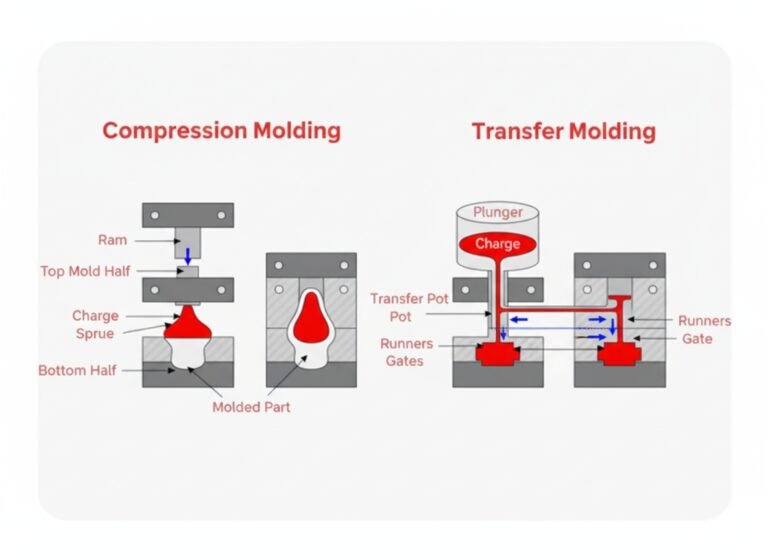Start A Rubber Molded Part Without Defects!
Foaming of Molded Rubber Products
Causes: The molding material is not completely cured, air is not fully removed, and the mold temperature is too high, causing certain components in the material to vaporize or decompose.
Solution: Either increase the mold temperature or prolong the holding time, increase the number of exhausts, but avoid excessive mold temperature.
This rubber defect is more commonly seen in rubber compression molding and rubber transfer molding.
Lack of Materials for Molded Rubber Parts
Causes: Too large mold matching gap or too large flash hole, too much release agent, too slow or too fast operation.
Solution: Adjust the matching tolerance of the mold and the size of the overflow hole, and adjust the appropriate mold clamping temperature and pressurization time.
This rubber defect often occurs in compression molding and injection molding.
Burnt Molded Rubber Products
Cause: The mold temperature is too high, and the rubber has not had time to fully flow during the mold clamping process, and it has been partially vulcanized and lost its fusion ability.
Solution: Reduce the mold temperature appropriately.
This rubber compression molding defect is commonly observed.
Warpage of Molded Rubber Products
Causes: Incomplete curing, improper mold ejection process, and over-vulcanization caused by high temperature.
Solution: Improve the curing conditions, redesign the mold, and make the ejector device reasonable. Appropriately lower the mold temperature or shorten the vulcanization time.
This rubber defect is seen in both compression molding and injection molding. Learn more: Warpage in injection molding
The Dull Surface of Molded Rubber Parts
Causes: Mold temperature is too high or too low, mold sticking, mold surface rough.
Solution: Adjust the mold temperature, generally lower the mold temperature appropriately, and use a suitable mold release agent. It should be chrome plated to improve the surface finish of the mold.
This surface issue is common in compression and injection molding.
Molded Rubber Products Stick to Mold
Cause: The molding material lacks an appropriate release agent or the release agent is improperly applied. The mold surface is rough, or a new mold is used without proper polishing.
Solution: Add an appropriate amount of effective internal mold release agent through the test to improve the surface finish of the mold, and then press the glass fiber reinforced plastic after testing the mold with compression molding powder, and appropriately reduce the pressure.
This rubber compression molding defect is commonly observed.
Mottled Surface of Molded Rubber Products
Causes: Mold overheating, pigments decompose due to overheating.
Solution: Reduce the mold temperature.
This rubber compression molding defect is commonly observed.
Flash of Rubber Products
Causes: Mold mismatch, excessive material, low clamping pressure, or worn mold edges.
Solution: Improve mold alignment, reduce material volume, and ensure proper clamping force.
This rubber defect is more commonly seen in compression molding and injection molding.
Shrinkage of Rubber Products
Causes: Improper formulation, low pressure during molding, or inadequate cooling.
Solution: Adjust compound formulation, increase mold holding pressure and improve cooling system.
This rubber defect often appears in injection molding and transfer molding.
Cold Flow Marks With Rubber Parts
Causes: Low mold temperature, poor material fluidity, or slow injection speed. Solution: Increase mold temperature, optimize rubber formulation, and improve material flow.
This rubber defect is more common in injection molding.
Air Bubbles / Trapped Air
Causes: Poor exhaust design, fast mold closing, or inadequate preheating of the compound.
Solution: Improve mold venting, adjust closing speed, and ensure proper preheating of materials.
This is frequently seen in rubber compression and transfer molding defects.
Deformation After Demolding
Causes: Part not fully cured, demolding too early, or uneven shrinkage during cooling.
Solution: Extend curing time, allow sufficient cooling, and improve mold structure.
This rubber defect occurs more often in compression and injection molded parts.
Conclusion of Defects of Molded Rubber Products
The above content is the cause and solution of the molding of molded rubber products. Pay attention to our company if you want to know more professional knowledge. We are a professional manufacturer specializing in OEM&ODM customization rubber services. We have developed a one-stop solution from mold design and rapid prototyping to mass production based on 40 years of technical precipitation. Welcome to consult if necessary.



